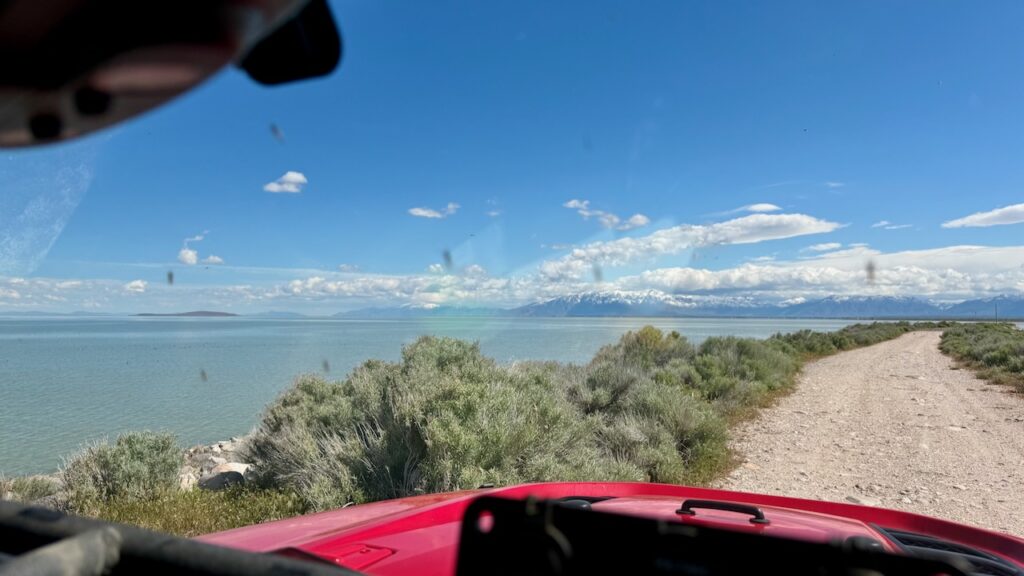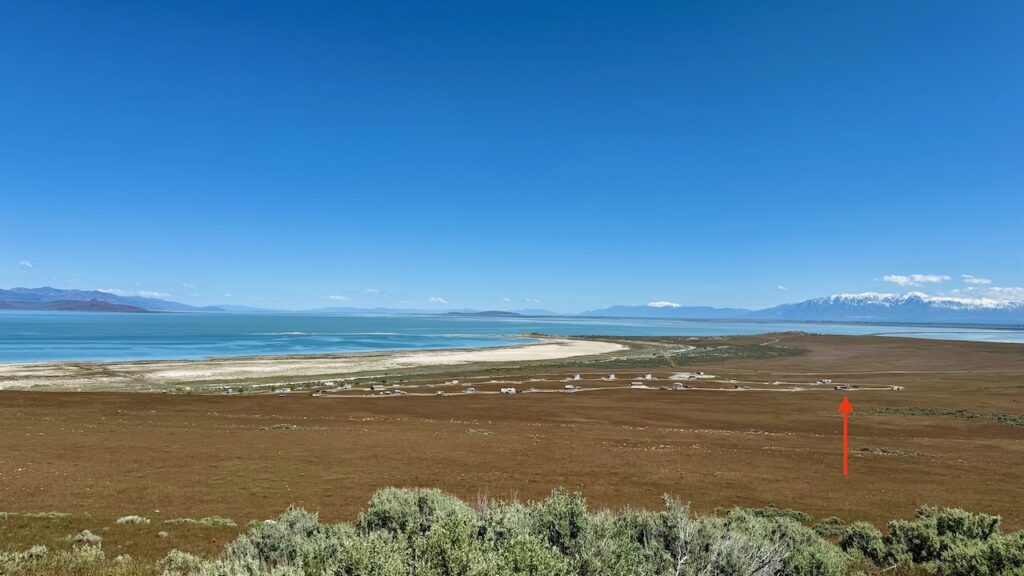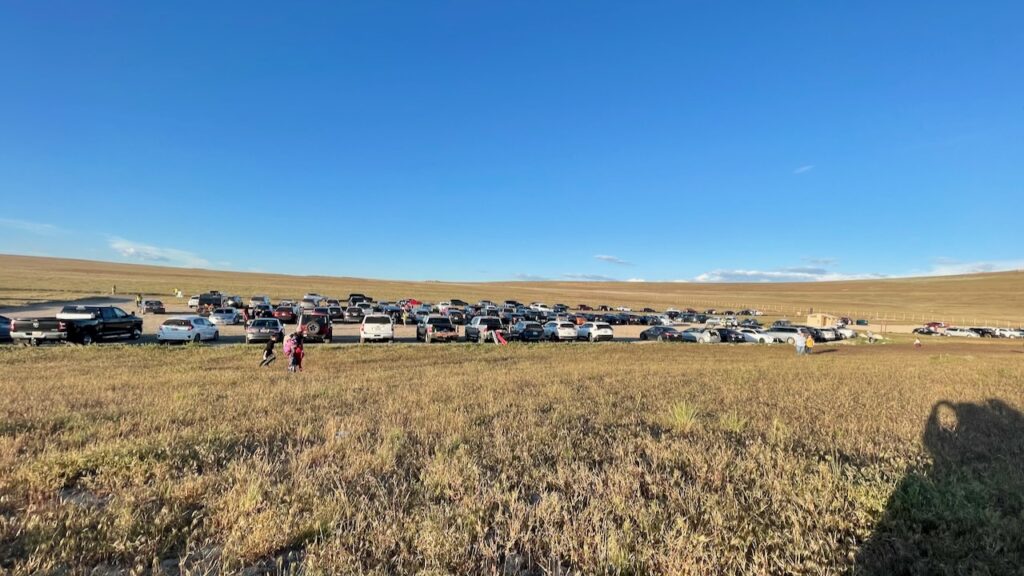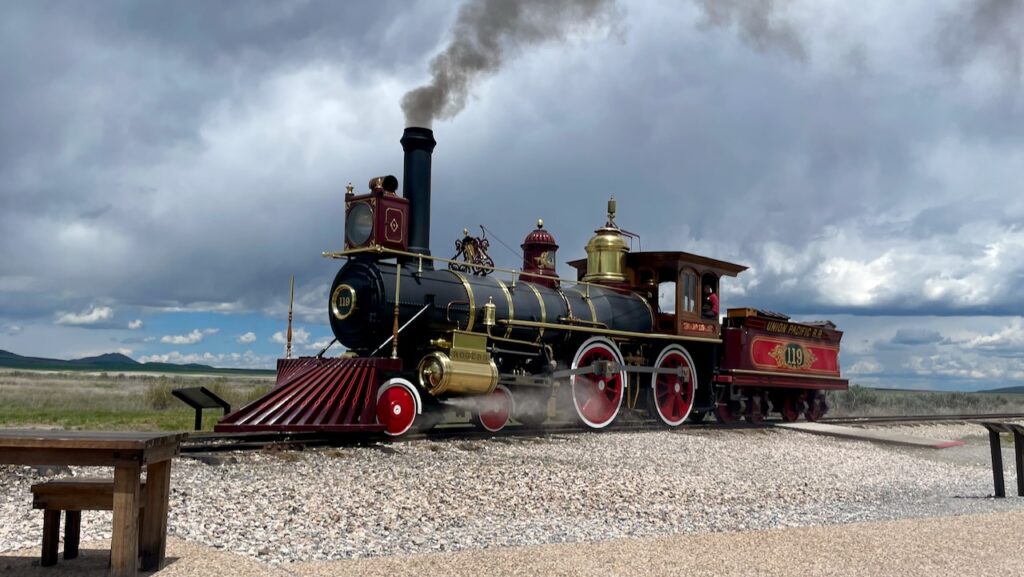Birds, Bison, Bugs and Brains, Oops, Trains
May 10-14 – Day 56-60
Antelope Island State Park, Syracuse UT
May 10, 2024
We stopped by the Visitors’ Center for the all important fine mesh bug nets. You see, Antelope Island is a special birding place. That’s because the Great Salt Lake is full of brine shrimp. And then there are the brine shrimp flies. The birds eat both the shrimp and flies. Plus the mosquitos which are large enough a traditional mesh bug net will keep them off you. But then you have the biting gnats which totally ignore DEET. (susan here: it’s probably more of a lure than anything else.) So for the next several days we’d be wearing long sleeves, long pants, and keeping out bug nets close at hand if we were out and about on the island.
At the Visitors Center we observed dozens of Cliff Swallows building their mud nests. These were quite entertaining to watch.
We then spent the better part of the day exploring the island by Jeep looking for birds along the way. On the first off pavement road we found the same Cliff Swallows collecting the mud for their nest.

We watched them for awhile and drove out a short single lane jetty near the marina. The first thing we noticed were the mosquitos!

They were everywhere. Those aren’t dead bugs on the windshield, that comes later, those were bugs that had landed on the windshield. What the picture didn’t capture was the swarm of mosquitoes. This species is big and are easily 3 times what we have back home.
We watched a huge flock of Eared Grebes for a bit. While trying to figure out if there was another species in there we would see flashes of white all over the place. Eventually we figured it out, these grebes were white underneath and would lift a leg to scratch or preen and their white belly would pop out of the water. As we were leaving we parked at a different spot and spotted a blackish bird, thinking it was “just” a starling we almost didn’t look closer. We’re glad we did! It was quite cooperative, almost posing for us, and soon we realized we were seeing Brewer’s Blackbird.
Further down the main causeway we encountered thousands of the Eared Grebe. For as far as the eye could see it was Grebes. It felt like every Eared Grebe in the world was gathered there. We were in the heart of migration time and it sure looked like it.
The views along the causeway were stunning.

We spent a few hours out there and had a great time. Back at camp we finally got a great look at the Black-Billed Magpie. Earlier in the day we got a fleeting glance of one and hoped we’d see another one before leaving the island. This one hopped up onto our picnic table! Later on during our stay at Antelope State Park we’d hear them running around on the RV’s roof. We’re pretty sure they were caching food up there. Not their smartest idea since we drove away with their cache of food or treasures. (susan here: and here we hoped that we would see them again but apparently they’re pretty common. We saw them all over the island, in Ogden and beyond. That’s not a bad thing because they’re really pretty but very common.)
Nature wasn’t done with spectacular scenery. We saw a rainbow while doing our evening stuff.

And finally, just before dark, we had an incredible sunset to the east, where the setting sun was lighting up the clouds over the mountains to the east. These mountains are the very western edge of The Rockies and they’re still capped in snow.

Life Birds: 3 (Cliff Swallow, Brewer’s Blackbird, Eared Grebe)
May 11, 2024
More exploring and birding today. That’s a big surprise, huh? We specifically chose Antelope Island because it is a birding mecca–unlike the “false” advertising of the Salton Sea. We scheduled things so that we’d be there at the height of the typical bird migration cycle.
We drove to the top of Buffalo Point, thinking that it might be a different birding habitat since it was higher elevation. It had a lot of people up there. Any self respecting birds would just fly away. We did get to see a good view of our campground. The red arrow points to our RV. The campsites are really far from each other compared to a typical campground. Each site was about 200′ wide with so much land to the rear it was like having a backyard. If you were to imagine a street with houses you’d have about a 1/4 acre or more to yourself. Our “backyard” is a field of grass that runs for 1500′ up to Buffalo Point. The only cars or human activity that you’d hear were the comings and goings of people staying in the campground. Otherwise it was void of human sounds but filled with nature sound (which sometimes was dead quiet). That’s why we chose to extend our stay here.

We found this cool little snake at the start of a fairly rugged nature walk. We think it’s a Gopher Snake. They’re non-venomous and dangerous only to small mammals, like gophers (duh!). At this size it’s probably eating insects and bird eggs.

We tried doing the rugged walk to the the top but the terrain was nasty with a lot of loose rocks and pebbles. With better shoes, probably our hiking poles and maybe being better adjusted to elevation we would have done it.
There are about 700 bison on the island, but we had only seen about 2 dozen or so. We had read that most of them lived on the south part of the island. After poking around Buffalo Point we headed down that way. We found them! (susan here: not hard to find as they were in a field next to the road.) This group was a maternal herd and there were many babies running about. The bison we saw in the campground are the bulls and they live separate from the cows unless it’s breeding season.

Antelope Island is a refuge for one of the oldest and largest public herds of bison in the United States. Introduced in 1893, the bison (buffalo) herd now numbers over 700 animals. Each fall, the bison are rounded up and some are sold to limit the size of the herd within the carrying capacity of the island.
Large herds of bison are primarily comprised of cows, calves and young nonbreeding bulls. The older bulls stay to themselves most of the year in “bachelor” groups. Typically, only during breeding season (July-August) do the older bulls join the big herds. A 9-month gestation period leads to calving season in late spring.
On Antelope Island, most bison give birth to their calves high up on the east slope of the island. At higher elevations, there are more nutritious native grasses, more water and it is cooler. They may also travel to these high elevations to get away from people. As a result, no trails or developments are planned for the east slope of Antelope Island. The east slope is closed to people, to preserve it forever as a refuge for bison and other
A plaque on the site
We saw three distinct maternal herds, easily totalling 500 or more bison. It is hard to count. Paul took some photos of the first set and using standard “fish counting” techniques, which involves circling groups of 5 or 10 on the photo, counted about 125 bison in that first herd.

We kept on heading south until we hit the end of the pavement and arrived at Fielding Garr Ranch.
The Fielding Garr Ranch is located at Garr Springs, which is one of the strongest and most consistent springs of the 40 known springs on Antelope Island, though even this spring has shown some signs of drying up in recent years. The ranch is one of the oldest working ranching operations in the Western United States. The ranch was initially established in 1848, the year after the first Mormon pioneers came into the Salt Lake Valley. Fielding Garr, a widower with nine children, was sent by the Church of Jesus Christ of Latter-day Saints (LDS Church) to live on Antelope Island and establish a ranch to manage the church’s Tithing Herds of cattle and sheep. The first building was an adobe house built in 1848 by pioneers of European descent and it is still in existence as the oldest building in Utah that still remains on its original foundation. The adobe ranch house was continuously inhabited thereafter until 1981 when the State of Utah prepared to set up Antelope Island as a Utah State Park. At various times other people tried to live on the island, but the harsh conditions, isolation and a lack of fresh water made it very difficult.
https://en.wikipedia.org/wiki/Fielding_Garr_Ranch
We wandered around the site, peering into the various buildings, including the main house and several barns.

There area around the spring was wonderful and it’s a designated Audubon Bird site. It was much cooler in the trees and there were lots of birds singing and flying from branch to branch. We met a birder that was engaged in the Salt Lake City Bird hunt. You get 1 point for hearing the bird, 2 points for seeing it, and 4 points for photographing it. You have from 6AM to 11PM to get the most BIPs, Bird I-something Points (bragging rights). This contest was running in conjunction with a National Bird Count that day.

If you could stand the bugs it’s a wonderful place to have a farm. You are surrounded by beauty and can escape the heat by going into the woods around the spring.

The previous night was the big aurora night. We didn’t even try to see it since we figure it was both too cloudy and that we were too far south. All the news reports the next morning talked about how wonderful it was so we decided to see it that night.
The Salt Lake City astronomy club holds a monthly “star party” on the island. There was a promise of solar telescopes being available to view the sunspots plus regular night-time telescopes for after sundown. Paul really want to go to this event. It’s been a while since he’s done any astronomy. After an early dinner we headed to the site.
After about an hour the parking lot was full and it eventually overflowed to the road. There weren’t any telescopes or any hint of organization in sight. With a couple hundred people there, even if they had telescopes there would be long lines to view anything. We figured out what had happened. These were all city people who hadn’t seen the aurora the night before because cities are too bright. Probably the local media publicized the star party and they showed up in droves.

Between the bugs and lack of a star party we made the joint decision to go back to the RV, play games, and wait for dark to see the aurora from the comfort and emptiness of our campsite.

Susan played as a teenager but hadn’t played again until recently. She started up again when we were in Phoenix and is getting better each game. She’s playing white above and you can see that Paul was able to promote a pawn to queen before she did. She lost that game but the next day she got her first draw against Paul, who has lots more experience.
Sunset was around 8:30. We waited until it got really dark and went outside around 9:30, let our eyes dark adapt and waited. And it eventually showed up! Susan saw it first, Paul had seen the brightening to the north but had dismissed it as city glow. Then we both saw the vertical striations, Paul still wasn’t convinced, so he moved so a campground light couldn’t be the source of the striations. There were still there.

You must remember, that this is just a photo. The eye did not see all of this. You could make out the lines but they weren’t this distinct to the naked eye. Susan was able to see a hint of green with the pink, Paul only saw a very faint pink.
We stayed out until about 11:30pm. It was getting colder plus the aurora had waned and never came back. Around 5AM something woke Paul up and he looked outside the bedroom window and was immediately blinded by the power pedestal light, so he didn’t even bother getting all dressed up and going outside.
May 12, 2024
The 12th is a real slow day. We got up late since we stayed up late, did some birding, and saw this incredible mirror smooth water surface.

Later in the afternoon we headed to Ogden to meet up with a friend who made two fantastic smoked chickens plus a few sides. It was all very delish!
Can you imagine living in a place with this kind of view downtown?

Paul setup his ham radio gear along so that Vinny could talk to his dad back home (his dad, Glenn, is also our friend). Paul, Vinny and Glenn are all hams. The solar interference, or the electric interference from all the houses, or even just the nearby mountains made all contact impossible so that was a bust. It was a work night for Vinny so we headed back to the RV early where we played more chess. Susan drew Paul again. Paul think she’s going to pull a win before we get back home. Susan is less sure of that happening.
May 13, 2024
Birds! Birds! Birds! That’s what was on the docket for the day. We prepped lunches, snacks and plenty to drink. We drove all over the island finding 13 different species of birds, 4 of which were new to us. One interesting bird we saw was a Herring Gull. Interesting? Back home they’re as common as sand on a beach. Out here they are mostly replaced with California Gulls and Western Gulls. All three species are very similar in appearance and only distinguished by various part of their body. This bird had Herring Gull legs and California Gull eyes! Our guess is that it was a hybrid. The Bird police have not yet contacted Paul so we’ll see if they say anything. (Update, May 17, the Herring Gull was a CA Gull, the beak spot and size were diagnostic, Paul had heard from Cornell.)
Glenn, Paul’s friend back home still wanted to talk to his son Vinny. (Note: They talk on the phone all the time. This was more of a “proof of concept” to see if it would work.) The solar storms that brought the beautiful auroras were still bad but it was worth a try so Paul setup his ham radio equipment at the campground.
The first he noticed was that something was going to go wrong was when the RV’s awning automatically retracted. Unknown to us it has a wind sensor. Then a big gust blew the antenna around and then down. He almost always guys the antenna with weights but didn’t this time because when he set up the winds were zero (remember that glassy water picture from the other day, same today). So he weighted the antenna with 2 gallon jugs of water. The short antenna was still bending a lot.

Glenns gets the message that Paul is all setup so he walked up his big hill to do his setup. Paul wasn’t hearing anything and he wants to try a different set of frequencies, or a “band” but, that meant changing the antenna to a taller 17′ one. It was only about 2/3rds deployed when the winds started moving the tripod sideways across the pavement. Paul immediately shut everything down. There was no ham radio to be had that day.
Life Birds: 4 (Lark Sparrow, California Gull, Western Grebe, Common Goldeneye)
May 14, 2024
Today we didn’t look for birds! We visited the Golden Spike National Historic Park.
One of the greatest technological achievements of the 19th century is the completion of the first transcontinental railroad across the United States. Visitors to the park can see the location of the Last Spike Site, 1869 railroad construction features, walk or drive on the original railroad grade, and get an up close view of Victorian era replica locomotives.
https://www.nps.gov/gosp/index.htm
We left using the now familiar to us 7 miles of causeway and saw The Bugs!

Side story: Look carefully at the black clouds along the sides of the road above the greenery. Those are swarms of bugs, we didn’t stop to find out the species. The Jeep is covered in bugs. The sound of them hitting the windshield was like hearing individual raindrops at the beginning of a rainstorm. Windshield washer fluid did very little. We had gassed up the day before. While Paul was filling the gas Susan got about 75% of them off by liberally soaking the windshield with the cleaning fluid, letting it sit, rubbing hard/wiping it dry and repeating. We’re not sure what we are going to do about it.
The nearest town to the Golden Spike site is 27 miles west of Corinne, Utah which is in the middle of nowhere. So why not put an NASA Artemis test facility there run by Northrop Grumman? Hopefully no rockets blow up but the dirt berms around the buildings will probably protect…someone or something. We don’t really know. It’s one of those super-secret types of places.

Let me google that some. Oh my… See https://www.northropgrumman.com/space/nasas-artemis-program.

PROMONTORY, Utah – July 21, 2022 – Northrop Grumman Corporation (NYSE: NOC) and NASA successfully conducted a full-scale static fire of NASA’s Space Launch System (SLS) rocket motor, known as Flight Support Booster-2. The five-segment solid rocket booster is the world’s largest solid rocket motor and will provide more than 75 percent of the SLS rocket’s initial thrust during launch.
https://news.northropgrumman.com/news/releases/northrop-grumman-and-nasa-successfully-test-space-launch-system-booster
I guess they do test big rockets there!
And it is good to know that, out here in the middle nowhere, where they test rocket motors, that the urban planners still take a forward looking approach to street numbers. 22000 street? It looks like they have high hopes.

“In one mile, make a slight left turn onto North Twenty Two Thousand West.” Yes, that’s how they do things out here, it almost makes sense in the city, you know if you are east or west of the center, wherever that is, likewise for north and south of it. But out here?
We made it to the Golden Spike Building, got our National Park stamps and refrigerator magnets, then watched a 20 minute film about the history of the place. Remember that Chinese cemetery that was in our campground back in CA? Here is where we learned that 10,000 Chinese immigrants were labored to build the western part of the railroad. It was backbreaking work. One year there were able to lay just 15 miles of track. The Midwest team had it much easier, they were laying a mile an hour on a good day.
Then we went outside to see the trains!



Built in the 1970s, the 119 and Jupiter are reproductions of the locomotives that were used in 1869. As times changed and loads got larger, they were phased out and eventually scrapped in the early 1900s. For these reproductions the story is that Walt Disney had a hand in it. The story goes that it was because he was one of the last people left in the world still running steam. (We both find this a little hard to believe since we’ve seen so many steam trains running on all our journeys.)
Yes, they are painted vividly and even have gold leaf applied to them! That is historically accurate. We’ve all seen the “painted ladies,” the restored Victorian homes.These locomotives were from the same time period thus the gilded decorations. Once curious note is that the 119 was a coal fired steam locomotive. They didn’t have access to the amount of wood needed to run a locomotive but coal was readily available. However, the Jupiter was wood fired since they did not have access to coal on the west coast only wood.
You can read the linked articles above for a lot more detail on the trains.
The building was stone, which isn’t surprising consider that we are in desert grasslands, but the stone itself told a story.

Park Valley Rock
Located approximately sixty miles northwest of Golden Spike NHS, near the town of Park Valley, Utah, quarries of unique red and green rock were tapped to obtain the material used to build this Visitor Center. The red rock is ferrous (iron) quartzite, and the green rock is cupreous (copper) quartzite. The only other cupreous quartzite quarry is located in China.
On the way home we saw a sign for the East and West (closed) auto audio tour. We weren’t feeling it, after all, you can only have so much trains, but we did go down one dirt road, “The Last Cut.”


We were driving on the real graded surface the trains used to ride on. The tracks have long since been removed, a causeway was put in across the Great Salt Lake which made for a much better route.
But you can’t argue with the view from there!

We made the long ride back to the RV and wondered what to do on our last night here at Antelope Island. We were chess’d out, didn’t want to play Ticket to Ride. But we were about 2 weeks behind in the blog so in one marathon session we wrote a bunch of blogs. We’ve barely had any cell service so we barely had any internet. But at least we’re now only a week or so behind!